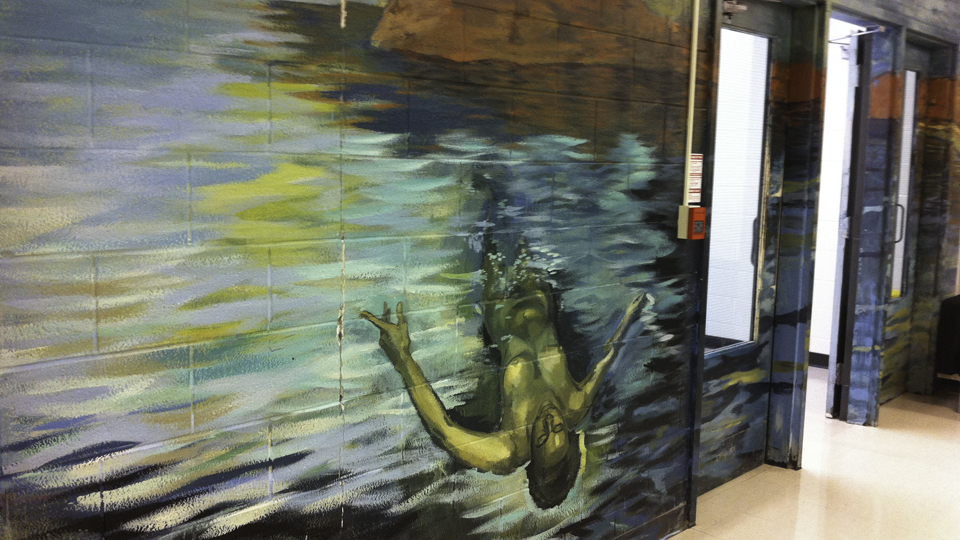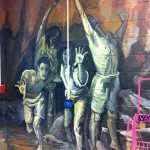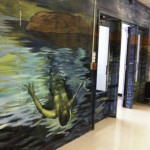If you’re an upper-year student at UTM, you’ve most likely seen the massive, haunting mural in the North Building’s upstairs lobby; more recent students may have missed it due to construction. Either way, there’s a good chance you don’t know much about the partially concealed, stunning work.
“Till the River” is an early work of Denyse Thomasos, a 1987 UTM graduate of the art and art history program. Thomasos—who passed away during a medical procedure in 2012 at the age of 47—is one of the few internationally renowned graduates of the program, according to John Armstrong, a professor of painting in the art and art history program. The piece was her first large-scale mural. Thomasos went on to paint murals in public art galleries, including the Living Arts Centre in Mississauga and the Art Gallery of Ontario.
The mural was completed in 1986 as part of a summer work grant. “We were in charge of choosing colours to repaint the North Building, and we thought it might be interesting to have some murals that reflected the experience of being a student at UTM,” says Armstrong.
“Till the River”, which depicts a river scene surrounded by bathing and protesting figures, reflects the anti-apartheid movement; Thomasos was an active member of the Caribbean African Student Society. The piece is painted onto the cinder blocks of the walls using Thomasos’ original technique of “stumbling” the paint.
The Toronto Star described Thomasos as a “powerfully confident artistic voice” in a recent article discussing her current exhibition at the MacLaren Art Centre in Barrie. In a 2012 article, they called her “aggressive and ambitious”. Unfortunately, Thomasos’ mural is being demolished as part of the North Building’s reconstruction. The North Building, originally meant for temporary use during the construction of the South (now William G. Davis) Building, was to be demolished in the early ’70s, so the destruction of Thomasos’ work has been a long time coming.
“It’s inevitable that if the building is to be rebuilt, it has to be removed,” says Armstrong.
Many students aware of Thomasos’ work are upset by the destruction of “Till the River”. As put by fifth-year art and art history specialist Irram Bhatti, “To destroy any piece of art in general […] it grabs your heart. Especially that one, how unfortunately she passed away—it’s a memoir to her.”
In one of UTM’s capital campaigns, adds Armstrong, Thomasos’ face was prominently displayed around campus.
Grace Bedwell, a fourth-year art and art history student, says, “It’s not pretty. It’s kind of out there. But we could look back and say, ‘Wow, we had a Denyse Thomasos original at one time, and it’s gone.’ But [that’s] also kind of the problem with murals.”
“They should put more effort into acknowledging her, because it makes the university look kind of ignorant to artists that have graduated from our program,” adds Bedwell. “I didn’t know anything about the mural until someone told me. UTM is very science-focused—there isn’t much recognition for the arts.”
“We’re fortunate to have the Blackwood Gallery. We have the Bernie Miller Lightbox, which is always engaging,” says Armstrong, adding that in terms of installed student art on campus, there could certainly be more.
In addition to the Blackwood Gallery and the Lightbox, UTM artists exhibit their works at ArtsFest, a student-run art festival.
Still, some current and former art and art history students, including Lexie Nelson, Julia Suave, Sonya Filman, Andrew Ihamaki, and Becky Roth, agree that our campus could use more student art. “[The school] seems to be continuing with a modernist style that you can see in the North Building plans. There doesn’t seem to be anywhere to paint a mural,” says Bedwell. “I like the idea of having murals on campus—it [increases] student initiative to be connected to the school.”
“They could commission Work-Study students in our program to paint for the school, and paint on boards so they are removable—you don’t have to tear it down,” suggests Bhatti.
“I went to Mount Allison University, where Alex Coville, an acclaimed painter, was a student, and his murals are still up there,” says Armstrong. “As a young art student, I used to love walking around the campus and looking at his early works. We wanted to improve the experience of being in the building for students and faculty by having [Thomasos’s] mural.”
Update: The author of this article won a C Magazine Award for Excellent in Art Writing from Sheridan College for this article.






Oct 29, 2013 @ 17:38:00
That’s just the nature of mural painting – if the building goes down, it goes along with it.
However, I think it would be great if a good quality picture could be taken of it, and hung in the new building.